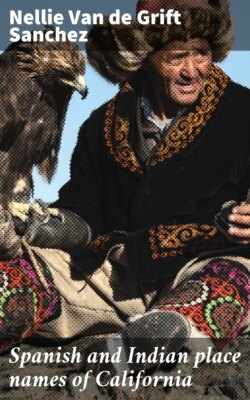Читать книгу Spanish and Indian place names of California - Nellie van de Grift Sanchez - Страница 12
На сайте Литреса книга снята с продажи.
IV
LOS ÁNGELES AND HER NEIGHBORS
ОглавлениеTable of Contents
Los Ángeles (the angels). In the diary of Miguel Costansó, date of August 2, 1769, we read: “To the north-northeast one could see another water-course or river bed, which formed a wide ravine, but it was dry. This water-course joined that of the river, and gave clear indications of heavy floods during the rainy season, as it had many branches of trees and debris on its sides. We halted at this place, which was named La Porciúncula. Here we felt three successive earthquakes during the afternoon and night.”—(Translation edited by Frederick J. Teggart.)
This was the stream upon which the city of Los Ángeles was subsequently built and whose name became a part of her title. Porciúncula was the name of a town and parish near Assisi which became the abode of St. Francis de Assisi after the Benedictine monks had presented him, about 1211, with the little chapel which he called, in a jocular way, La Porciúncula (the small portion). By order of Pius V, in 1556 the erection of a new edifice over the Porciúncula chapel was begun. Under the bay of the choir is still preserved the cell in which St. Francis died, while a little behind the sacristy is the spot where the saint, during a temptation, is said to have rolled in a brier-bush, which was then changed into thornless roses.—(Catholic Encyclopedia.) In this story there is a curious interweaving of the history of the names of our two rival cities, St. Francis in the north and Los Ángeles de Porciúncula in the south.
Continuing their journey on the following day, the Portolá party reached the Indian ranchería (village) of Yangna, the site chosen for the pueblo established at a later date. Father Crespi writes of it thus: “We followed the road to the west, and the good pasture land followed us; at about half a league of travel we encountered the village of this part; on seeing us they came out on the road, and when we drew near they began to howl, as though they were wolves; we saluted them, they wished to give us some seeds, and as we had nothing at hand in which to carry them, we did not accept them; seeing this, they threw some handfuls on the ground and the rest in the air.”
August 2 being the feast day of Nuestra Señora de los Ángeles, as the Virgin Mary is often called by the Spaniards, this name was given to the place.
The actual founding of the pueblo did not occur until September 4, 1781, when Governor Neve issued the order for its establishment upon the site of the Indian village Yangna. It is said that the Porciúncula River, henceforth to be known as the Los Ángeles, at that time ran to the east of its present course. The name of the little stream was added to that of the pueblo, so that the true, complete title of the splendid city which has grown up on the spot where the Indian once raised his wolf-like howl is Nuestra Señora la Reina de los Ángeles de Porciúncula (Our Lady the Queen of the Angels of Porciúncula).
The social beginnings of Los Ángeles were humble indeed, the first settlers being persons of mixed race, and the first houses mere hovels, made of adobe, with flat roofs covered with asphalt from the springs west of the town.
